Pioneer Use of Pseudo Sub-Daily Timestep Model for Rainwater Harvesting Analysis: Acceptance over Hourly Model and Exploring Accuracy of Different Operating Algorithms
Abstract
1. Introduction
2. Methodology and Data
3. Results
3.1. Comparison with Daily (YAS and YBS) Models
3.2. Comparisons with 6-Hourly (YAS and YBS) Timestep Models
3.3. Comparisons for Reliability Values
4. Conclusions
Author Contributions
Funding
Institutional Review Board Statement
Informed Consent Statement
Data Availability Statement
Conflicts of Interest
References
- Khan, Z.; Alim, M.A.; Rahman, M.M.; Rahman, A. A continental scale evaluation of rainwater harvesting in Australia, Resources. Conserv. Recycl. 2021, 167, 105378. [Google Scholar] [CrossRef]
- Shadeed, S.; Alawna, S. Optimal Sizing of Rooftop Rainwater Harvesting Tanks for Sustainable Domestic Water Use in the West Bank, Palestine. Water 2021, 13, 573. [Google Scholar] [CrossRef]
- Zhang, S.; Jing, X.; Yue, T.; Wang, J. Performance assessment of rainwater harvesting systems: Influence of operating algorithm, length and temporal scale of rainfall time series. J. Clean. Prod. 2020, 253, 120044. [Google Scholar] [CrossRef]
- Bailey, R.T.; Beikmann, A.; Kottermair, M.; Taboroši, D.; Jenson, J.W. Sustainability of rainwater catchment systems for small island communities. J. Hydrol. 2018, 557, 137–146. [Google Scholar] [CrossRef]
- Lopes, V.A.; Marques, G.F.; Dornelles, F.; Medellin-Azuara, J. Performance of rainwater harvesting systems under scenarios of non-potable water demand and roof area typologies using a stochastic approach. J. Clean. Prod. 2017, 148, 304–313. [Google Scholar] [CrossRef]
- Guizani, M. Storm Water harvesting in Saudi Arabia: A multipurpose water management alternative. Water Resour. Manag. 2016, 30, 1819–1833. [Google Scholar] [CrossRef]
- Lizárraga-Mendiola, L.; Vázquez-Rodríguez, G.; Blanco-Piñón, A.; Rangel-Martínez, Y.; González-Sandoval, M. Estimating the Rainwater Potential per Household in an Urban Area: Case Study in Central Mexico. Water 2015, 7, 4622–4637. [Google Scholar] [CrossRef]
- Bocanegra-Martínez, A.; Ponce-Ortega, J.M.; Nápoles-Rivera, F.; Serna-González, M.; Castro-Montoya, A.J.; El-Halwagi, M.M. Optimal design of rainwater collecting systems for domestic use into a residential development. Resources. Conserv. Recycl. 2014, 84, 44–56. [Google Scholar] [CrossRef]
- Imteaz, M.A.; Adeboye, O.; Rayburg, S.; Shanableh, A. Rainwater harvesting potential for southwest Nigeria using daily water balance model. Resources. Conserv. Recycl. 2012, 62, 51–55. [Google Scholar] [CrossRef]
- Bashar, M.Z.I.; Karim, M.R.; Imteaz, M.A. Reliability and Economic Analysis of Urban Rainwater Harvesting: A Comparative Study within Six Major Cities of Bangladesh. Resour. Conserv. Recycl. 2018, 133, 146–154. [Google Scholar] [CrossRef]
- Mehrabadi, M.H.R.; Saghafian, B.; Fashi, F.H. Assessment of residential rainwater harvesting efficiency for meeting non-potable water demands in three climate conditions. Resour. Conserv. Recycl. 2013, 73, 86–93. [Google Scholar] [CrossRef]
- Basinger, M.; Montalto, F.A.; Lall, U. A rainwater harvesting system reliability model based on nonparametric stochastic rainfall generator. J. Hydrol. 2010, 392, 105–118. [Google Scholar] [CrossRef]
- Ali, S.; Zhang, S.; Yue, T. Environmental and economic assessment of rainwater harvesting systems under five climatic conditions of Pakistan. J. Clean. Prod. 2020, 259, 120–829. [Google Scholar] [CrossRef]
- Alim, M.A.; Rahman, A.; Tao, Z.; Samali, B.; Khan, M.M.; Shirin, S. Feasibility analysis of a small-scale rainwater harvesting system for drinking water production at Werrington, New South Wales, Australia. J. Clean. Prod. 2020, 270, 122437. [Google Scholar] [CrossRef]
- Imteaz, M.A.; Moniruzzaman, M. Spatial variability of reasonable government rebates for rainwater tank installations: A case study for Sydney, Resources. Conserv. Recycl. 2018, 133, 112–119. [Google Scholar] [CrossRef]
- Jing, X.; Zhang, S.; Zhang, J.; Wang, Y.; Wang, Y. Assessing efficiency and economic viability of rainwater harvesting systems for meeting non-potable water demands in four climatic zones of China. Resour. Conserv. Recycl. 2017, 126, 74–85. [Google Scholar] [CrossRef]
- Basheer, M.; Elagib, N.A. Temporal analysis of water-energy nexus indicators for hydropower generation and water pumping in the Lower Blue Nile Basin. J. Hydrol. 2019, 578, 124085. [Google Scholar] [CrossRef]
- Wurthmann, K. Assessing storage requirements, water and energy savings, and costs associated with a residential rainwater harvesting system deployed across two counties in Southeast Florida. J. Environ. Manag. 2019, 252, 109673. [Google Scholar] [CrossRef] [PubMed]
- Chiu, Y.R.; Tsai, Y.L.; Chiang, Y.C. Designing rainwater harvesting systems cost-effectively in a urban water-energy saving scheme by using a GIS-simulation based design system. Water 2015, 7, 6285–6300. [Google Scholar] [CrossRef]
- Vieira, A.S.; Beal, C.D.; Ghisi, E.; Stewart, R.A. Energy intensity of rainwater harvesting systems: A review. Renew. Sustain. Energy Rev. 2014, 34, 225–242. [Google Scholar] [CrossRef]
- Waseem, M.; Lin, Z.; Liu, S.; Zhang, Z.; Aziz, T.; Khan, D. Fuzzy compromised solution-based novel home appliances scheduling and demand response with optimal dispatch of distributed energy resources. Appl. Energy 2021, 290, 116761. [Google Scholar] [CrossRef]
- Waseem, M.; Lin, Z.; Liu, S.; Sajjad, I.A.; Aziz, T. Optimal GWCSO-based home appliances scheduling for demand response considering end-users comfort. Electr. Power Syst. Res. 2020, 187, 106477. [Google Scholar] [CrossRef]
- Imteaz, M.A.; Shanableh, A.; Rahman, A.; Ahsan, A. Optimisation of Rainwater Tank Design from Large Roofs: A Case Study in Melbourne, Australia. Resources. Conserv. Recycl. 2011, 55, 1022–1029. [Google Scholar] [CrossRef]
- Paudel, U.; Imteaz, M.A. Spatial Variability of Reasonable Government Rebates for Rainwater Tank Installations: A Case Study for Adelaide. In Sustainability Perspectives: Science, Policy and Practice; Khaiter, P.A., Erechtchoukova, M.G., Eds.; Springer: Berlin/Heidelberg, Germany, 2019; Chapter 13; ISBN 978-3-030-19549-6. [Google Scholar] [CrossRef]
- Gómez, Y.D.; Teixeira, L.G. Residential rainwater harvesting: Effects of incentive policies and water consumption over economic feasibility. Resour. Conserv. Recycl. 2017, 127, 56–67. [Google Scholar] [CrossRef]
- Imteaz, M.A.; Paudel, U.; Santos, C. Impacts of climate change on weather and spatial variabilities of potential water savings from rainwater tanks. J. Clean. Prod. 2021, 311, 127491. [Google Scholar] [CrossRef]
- Santos, C.; Imteaz, M.A.; Ghisi, E.; Matos, C. The effect of climate change on domestic rainwater harvesting. Sci. Total Environ. 2020, 729, 138967. [Google Scholar] [CrossRef]
- Imteaz, M.A.; Moniruzzaman, M. Potential impacts of climate change on future rainwater tank outcomes: A case study for Sydney. J. Clean. Prod. 2020, 273, 123095. [Google Scholar] [CrossRef]
- Haque, M.M.; Rahman, A.; Samali, B. Evaluation of climate change impacts on rainwater harvesting. J. Clean. Prod. 2016, 137, 60–69. [Google Scholar] [CrossRef]
- Imteaz, M.A.; Boulomytis, V.T.G. Improvement of rainwater harvesting analysis through an hourly timestep model in comparison with a daily timestep model. Water Resour. Manag. 2022, 36, 2611–2622. [Google Scholar] [CrossRef]
- Lade, O.; Oloke, D.; Chinyio, E.; Fullen, M. Use of multi-criteria decision analysis methods for water supply problems: A framework for improved rainwater harvesting. J. Environ. Sci. Eng. A 2012, 1, 909–917. [Google Scholar]
- Eroksuz, E.; Rahman, A. Rainwater tanks in multi-unit buildings: A case study for three Australian cities. Resour. Conserv. Recycl. 2010, 54, 1449–1452. [Google Scholar] [CrossRef]
- Beal, C.; South East Queensland Residential End Use Study: Final Report. Urban Water Security Research Alliance 2011, Technical Report No. 47. Available online: http://www.urbanwateralliance.org.au/publications/UWSRA-tr47.pdf (accessed on 15 July 2022).
- Imteaz, M.A.; Khan, M.S. Pioneer attempt of incorporating four variables in generalised equations for predicting water savings through rainwater tanks. Urban Water J. 2022, 19, 714–731. [Google Scholar] [CrossRef]
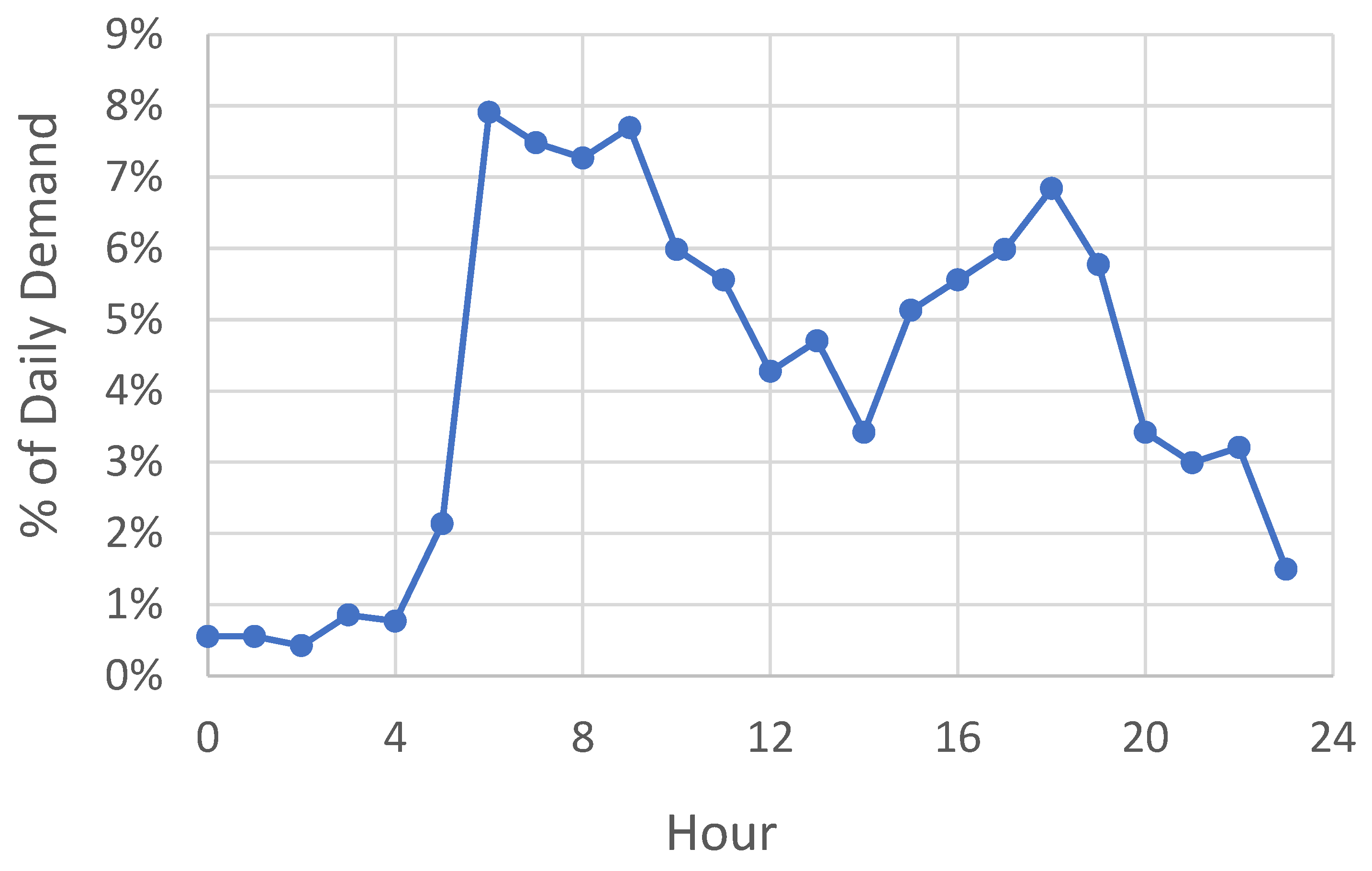
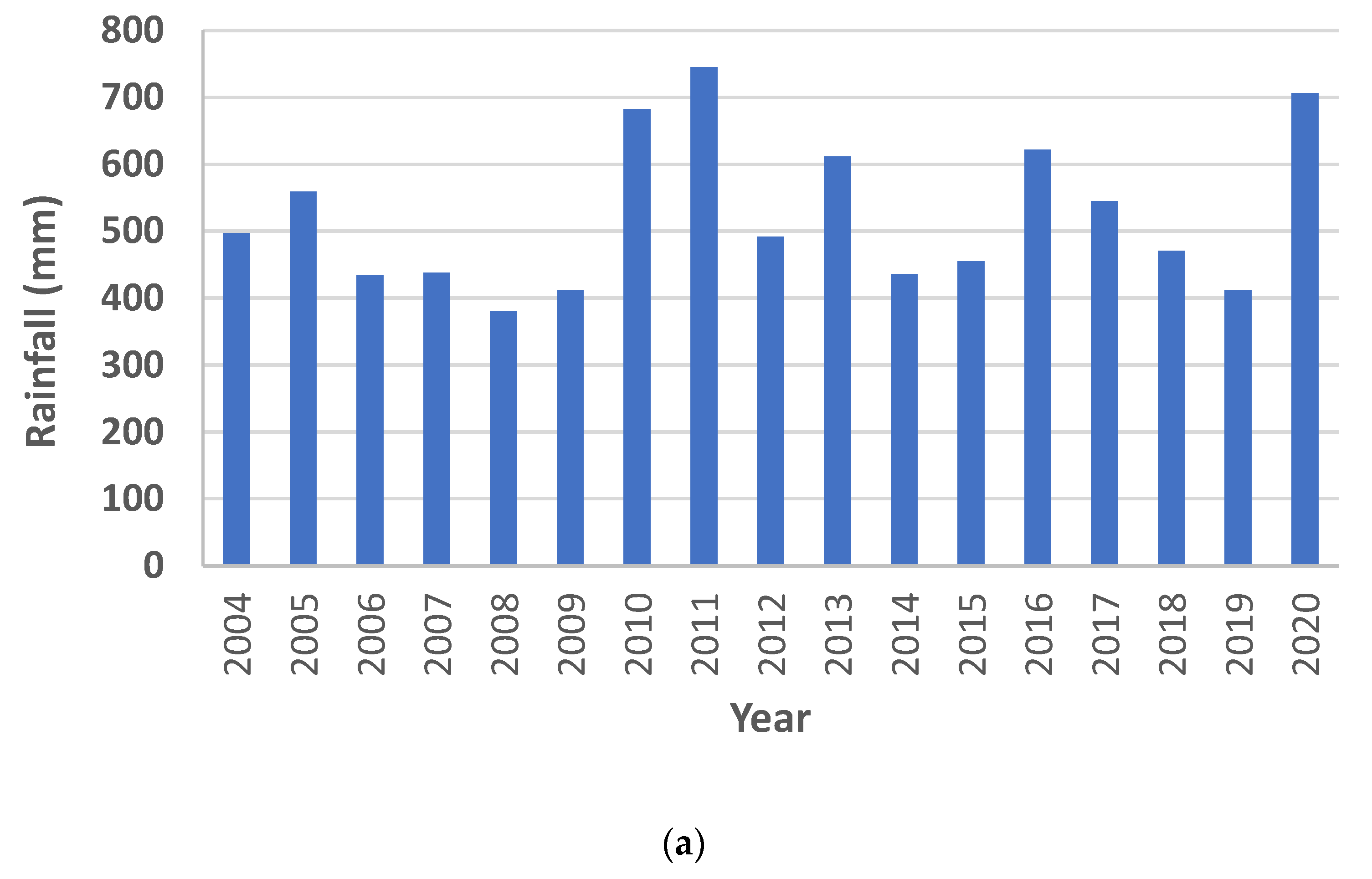

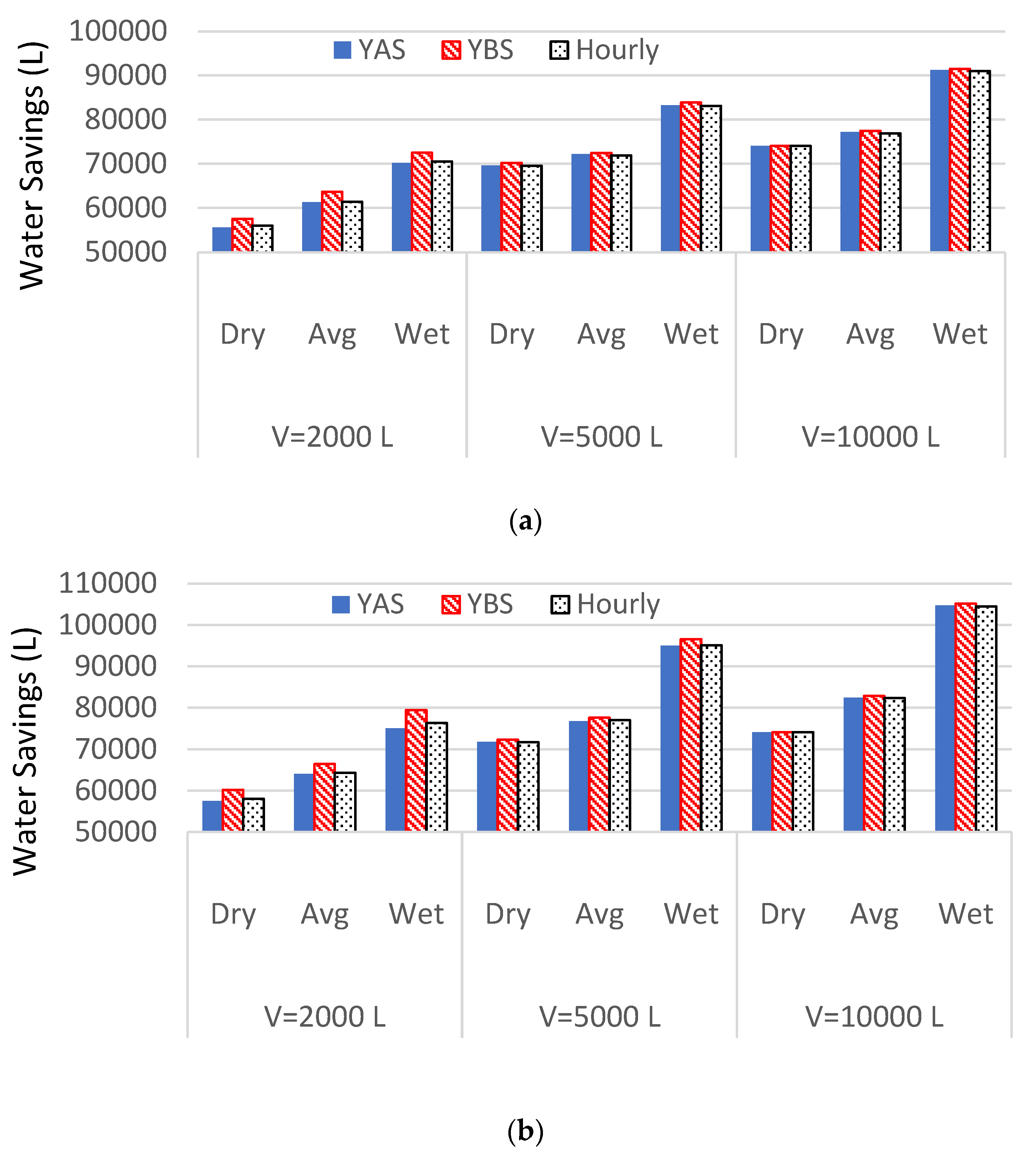
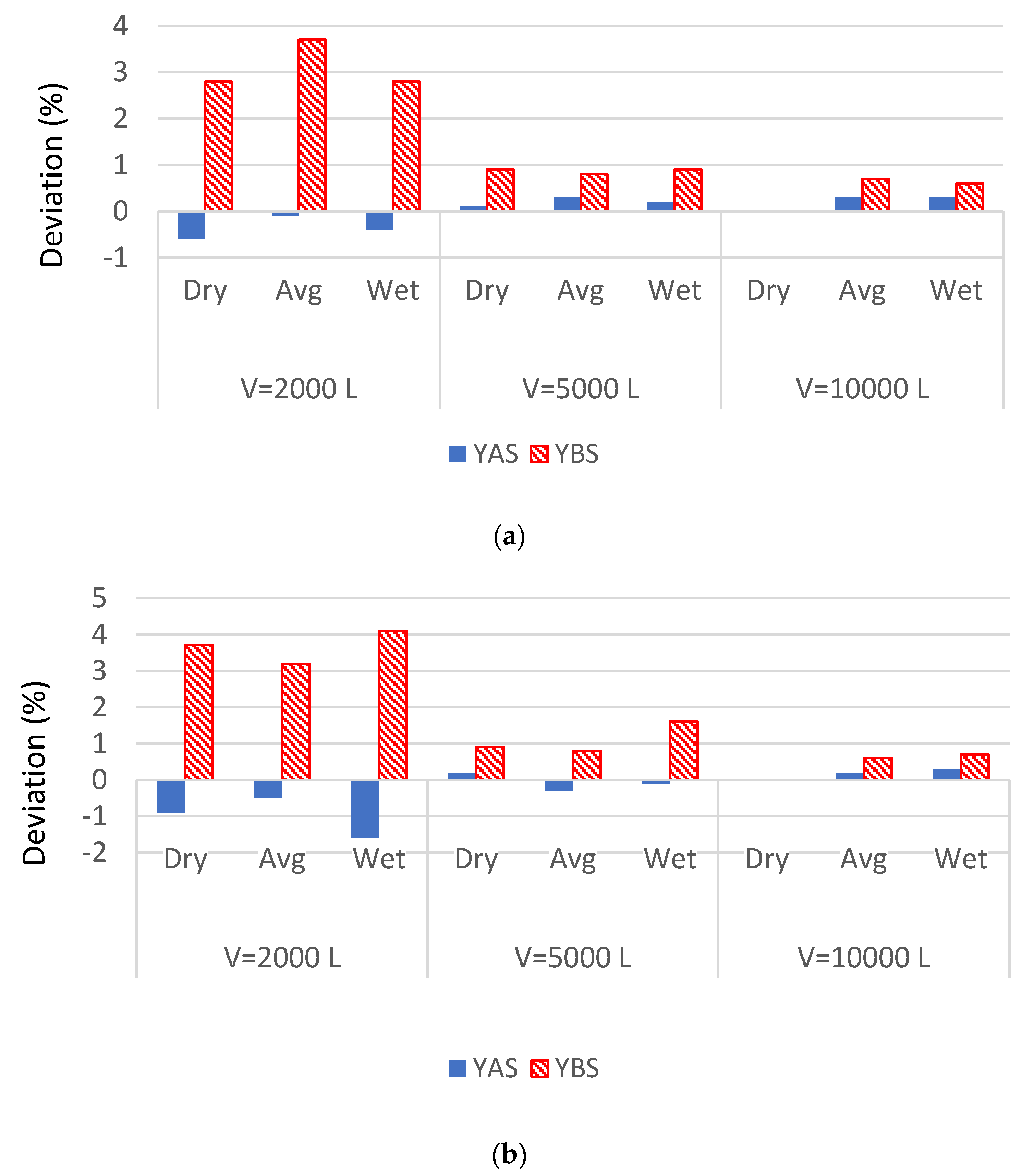
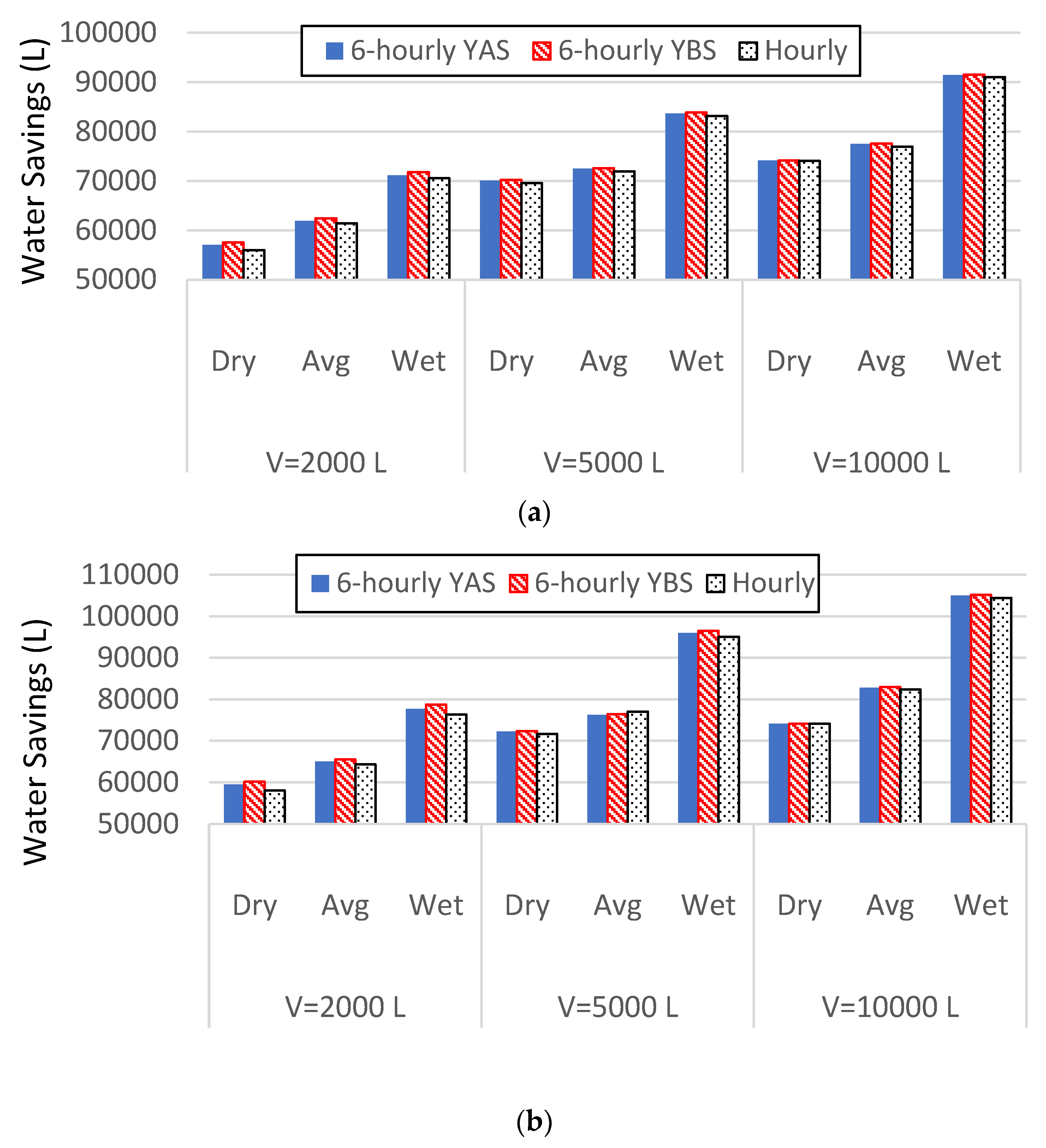

| Period | % of Total Demand |
|---|---|
| Midnight—6 a.m. | 5 |
| 6 a.m.—12 noon | 42 |
| 12 noon—6 p.m. | 29 |
| 6 p.m.—midnight | 24 |
| Midnight—6 a.m. | 5 |
| Weather | Year | Annual Rainfall (mm) |
|---|---|---|
| Dry | 2019 | 406.0 |
| Average | 2017 | 551.6 |
| Wet | 2011 | 731.0 |
| Parameter | Value |
|---|---|
| Station latitude and longitude | 37.73° S and 144.91° N |
| Station elevation | 78 m |
| Historical mean annual rainfall | 587 mm |
| Highest annual rainfall | 817.9 mm |
| Lowest annual rainfall | 350.4 mm |
| Tank Size (kL) | Weather Condition | Daily YAS Model | 6-Hourly YAS Model | 6-Hourly YBS Model | Hourly Model | ||||
|---|---|---|---|---|---|---|---|---|---|
| Daily Demand (L/day) | Daily Demand (L/day) | Daily Demand (L/day) | Daily Demand (L/day) | ||||||
| 300 | 400 | 300 | 400 | 300 | 400 | 300 | 400 | ||
| 2 | Dry | 45.2 | 31.5 | 50.1 | 37.8 | 50.5 | 38.6 | 50.8 | 39.4 |
| 2 | Avg | 48.5 | 35.3 | 54.2 | 41.0 | 54.5 | 41.4 | 56.0 | 43.8 |
| 2 | Wet | 57.3 | 42.2 | 63.2 | 49.6 | 63.8 | 50.3 | 64.3 | 52.2 |
| 5 | Dry | 60.3 | 43.0 | 62.9 | 47.3 | 63.0 | 47.3 | 63.3 | 48.8 |
| 5 | Avg | 60.0 | 44.9 | 64.3 | 48.8 | 64.5 | 49.0 | 65.6 | 52.6 |
| 5 | Wet | 71.8 | 57.8 | 75.2 | 62.7 | 75.4 | 63.1 | 75.7 | 65.0 |
| 10 | Dry | 65.2 | 44.7 | 66.7 | 48.6 | 66.7 | 48.6 | 67.3 | 50.5 |
| 10 | Avg | 65.2 | 49.6 | 69.3 | 53.6 | 69.4 | 53.7 | 70.1 | 56.1 |
| 10 | Wet | 80.3 | 66.9 | 82.7 | 69.8 | 82.7 | 69.9 | 83.0 | 71.4 |
Disclaimer/Publisher’s Note: The statements, opinions and data contained in all publications are solely those of the individual author(s) and contributor(s) and not of MDPI and/or the editor(s). MDPI and/or the editor(s) disclaim responsibility for any injury to people or property resulting from any ideas, methods, instructions or products referred to in the content. |
© 2023 by the authors. Licensee MDPI, Basel, Switzerland. This article is an open access article distributed under the terms and conditions of the Creative Commons Attribution (CC BY) license (https://creativecommons.org/licenses/by/4.0/).
Share and Cite
Imteaz, M.A.; Ahmad, H.; Hossain, I. Pioneer Use of Pseudo Sub-Daily Timestep Model for Rainwater Harvesting Analysis: Acceptance over Hourly Model and Exploring Accuracy of Different Operating Algorithms. Sustainability 2023, 15, 3870. https://doi.org/10.3390/su15053870
Imteaz MA, Ahmad H, Hossain I. Pioneer Use of Pseudo Sub-Daily Timestep Model for Rainwater Harvesting Analysis: Acceptance over Hourly Model and Exploring Accuracy of Different Operating Algorithms. Sustainability. 2023; 15(5):3870. https://doi.org/10.3390/su15053870
Chicago/Turabian StyleImteaz, Monzur A., Hassaan Ahmad, and Iqbal Hossain. 2023. "Pioneer Use of Pseudo Sub-Daily Timestep Model for Rainwater Harvesting Analysis: Acceptance over Hourly Model and Exploring Accuracy of Different Operating Algorithms" Sustainability 15, no. 5: 3870. https://doi.org/10.3390/su15053870
APA StyleImteaz, M. A., Ahmad, H., & Hossain, I. (2023). Pioneer Use of Pseudo Sub-Daily Timestep Model for Rainwater Harvesting Analysis: Acceptance over Hourly Model and Exploring Accuracy of Different Operating Algorithms. Sustainability, 15(5), 3870. https://doi.org/10.3390/su15053870











